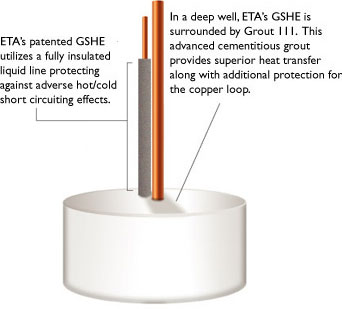



Technology
Geothermal heat pumps (also known as Ground-Source Heat Pumps, or GSHPs) are heating and cooling systems that use the same basic technology as central air-conditioning, but with two important differences:
- A heat pump can both cool AND heat…essentially, by running ‘backwards’ in the winter to provide heat in the same space that it cools in the summer.
- Ground Source means that the system extracts heat from the ground in the winter to heat your home or business, and deposits heat into the ground in the summer. This is done via pipes buried underground to form a ground loop (see below).

This diagram could represent cooling mode in the summer, or heating mode in the winter, depending on which way the fluid circulates. If it goes in hot (air conditioning mode), it gives up heat to the ground, and then absorbs heat from inside your house. If it goes in cold (heating mode), it captures heat from the ground and deposits it into your house.
Once you get below the frost line, ground temperature is relatively stable year-round….generally in the low 50s in the Northeast. So instead of trying to push heat out into the air on a hot day (as a conventional air conditioner does), the geothermal heat pump can much more easily get rid of the unwanted heat into the much cooler ground. This makes for ultra-high efficiency, and allows the system to operate with the same efficiency, regardless of the outside air temperature.
In addition, using an optional device called a de-superheater, some of that unwanted heat can be utilized to help heat the domestic hot water…so that you get ‘free’ pre-heating of the water your home or business uses every day. It’s efficiency on top of efficiency!

In the winter, that same ground can give up some of its virtually inexhaustible heat, as mentioned above. The electricity used to operate the system is, in effect, multiplied by as much as 5 times in terms of the amount of heat it provides for every kilowatt-hour it uses.

“Geothermal Version 2.0”
Older types of geothermal heat pumps use buried plastic pipe, and circulate a solution of water and anti-freeze through the ground loop, in much the same way that your car engine works with the car radiator.
Earth To Air Systems newer direct exchange (DX) technology circulates environmentally safe refrigerant through copper pipes in the ground. This has several advantages:
- Eliminates the complexity of a water-to-refrigerant heat exchanger
- Simpler = Greater Reliability
- More efficiently transfers heat to/from the ground through highly conductive copper instead of plastic pipe
- Requires less drilling for the required BTU capacity
- Higher operating efficiency, which translates to lower operating cost
- Copper lines are sealed into the boreholes with a thermally conductive cement mixture called Mix 111. This seals the hole to prevent groundwater contamination from surface runoff, provides additional protection for the copper lines, and efficiently conducts heat between the copper lines and the surrounding earth.

Cross-section of the Earth To Air Systems ground loop.
Learn more about Earth To Air Systems innovative technology.

Phone 973.993.9199 Fax 973.993.8444
39 East Hanover Ave. Morris Plains NJ 07950